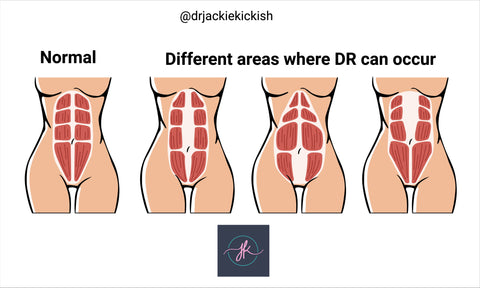Diastasis Recti 101
The most common complaint I hear from moms, especially newer moms is “I just can’t lose this mommy pooch, how do I get rid of it?”
If you feel like the postpartum belly just won’t go away, then I recommend checking yourself for an abdominal separation, also known as a diastasis recti around 6-8 weeks postpartum. There are other causes for the dreaded “mommy pooch” besides diastasis recti- which we will go into detail at a later date.
Did you know 100% of women have a diastasis recti at their due date?
And 60% of women have a diastasis recti 6 weeks postpartum.
Let's quickly review what is Diastisis Recti (DR)? It’s a separation or thinning of the linea alba. Linea alba is the thin connective tissue that connects the rectus abdominis muscles in the middle. It is very common for some separation to occur during pregnancy.
Diastasis recti is defined as a 2 finger width separation or gap between the rectus abdominis muscle. You want to check for width AND depth. Diastasis recti can occur above the belly button, at the belly button and below the belly button. The thinnest part of the linea alba is right above the belly button (hello, umbilical hernia).

How do we assess if we have a DR? Please watch my video HERE on how to test for a DR.
Please note to check along the entire linea alba and in all positions. Meaning, check yourself lying down, sitting, standing, and in the plank position. It may seem okay in the lying down position, but once in the plank position, you may be bulging.
Does depth or width matter more when it comes to abdominal separation/ DR? Most women I speak with are more concerned about the width or gap they have with their DR. When actually, it is the DEPTH that we should be more concerned about! Why is this? When checking for a DR, if you can push your fingers down in the gap and it feels soft or squishy- this means our deep core system is not firing correctly. Improving the depth will take longer than improving the width of an abdominal separation/diastasis recti.
It's important to be very cautious with exercises or activities that put increased stress and loading on your abdominal wall. Allowing too much intra-pressure during activities may cause injury, such as an umbilical hernia and impair the healing process for the diastasis recti. This is why it’s imperative that we properly and gradually load the core postpartum to prevent injury from occurring.
What else affects diastasis recti healing? There are multiple factors that could impair a DR from healing. This includes: poor posture and breathing pattern, rib flare and improper pressure management system (see above paragraph but we’ll dive more into this soon!). Improving our posture and making sure we are doing the 360 degree breathing pattern, which is essential in the first steps to healing a DR.
Can a diastasis heal on its own? Possibly! I know many women who have healed a DR without surgery, including myself. It really depends on how much damage to the fascial tissue occurred. Usually, a diastasis can heal conservatively with exercise if done properly. First, we must regain and focus on proper posture and breathing, which can be difficult after giving birth. Once our breathing and posture has improved, we can then focus on gentle strengthening of the core. If a DR is severe and conservative treatment, such as physical therapy is unsuccessful then surgery may be warranted.
I also want to share that it’s NEVER too late to heal your core! It doesn't matter if you are 3 months, 3 years or 30 years postpartum. The body is amazing with its ability to heal, and you can still work on your diastasis years after birth!
As you lay the foundation and your core becomes stronger, the exercises can be progressed to a more difficult level. It takes time and patience to heal a diastasis recti. It can seem frustrating at times as some of the things covered, such as breathing and posture are not very exciting, however, these are a non-negotiable for healing.
The goal is to be able to perform your daily functional tasks- such as squats, bending, lifting your baby and carrying objects with confidence (no pain or leaking), proper form and loading of your abdominals.
If you are interested in learning more about how to properly heal your core and pelvic floor, sign up for my waitlist so you can get the early bird prices and bonuses before my postpartum program launches in May of 2022! https://jackiekickish.com/pages/waitlist
If you haven’t already, you can also download my FREE postpartum exercise guide right here! https://jackiekickish.com/pages/simple-exercises


